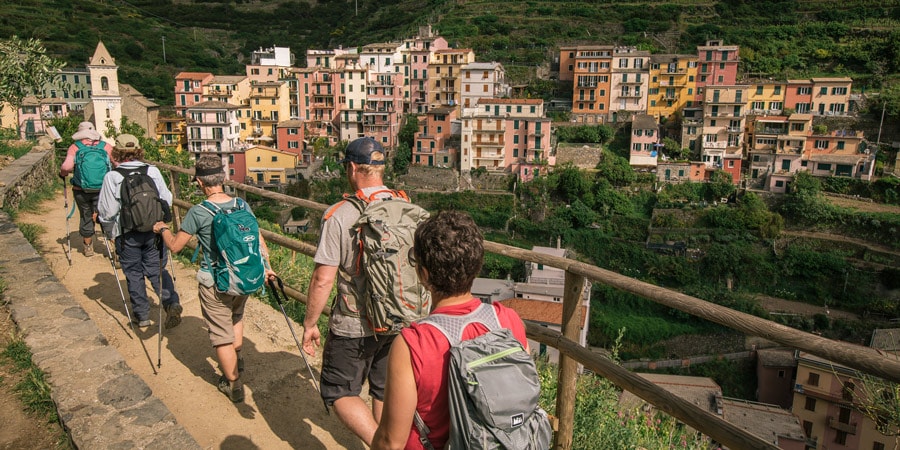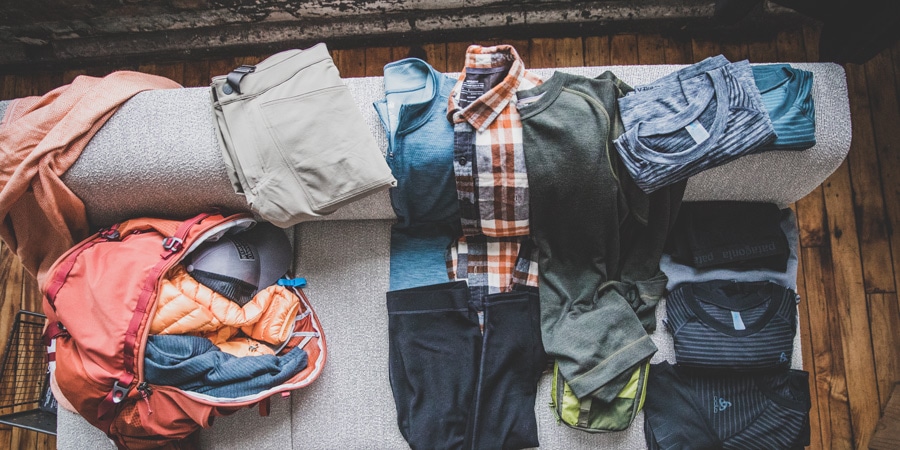Editor's note: This article was published prior to the COVID-19 pandemic. If you need to travel, check the CDC FAQ page about COVID-19 risks for travelers, which provides the latest guidance. For information about outdoor activities wherever you go (close to home is best), read Recreate Responsibly: An Activity-Specific Guide.
Packing for an international backpacking trip isn't just about making sure you bring the right gear. From TSA regulations to customs rules, there are several additional points to consider for overseas adventures.
This article will go over what to bring, how to pack and how to navigate international regulations.
What to Pack for International Backpacking

REI's backpacking gear list is a good place to start. Think carefully about how the gear you already have will hold up against the climate at your destination and the type of terrain you plan to cover. Solid footwear and a weatherproof jacket should be at the top of your list if you're traveling somewhere that can experience extreme weather conditions.
Along with the gear you would typically pack for a stateside backpacking trip, here are some extra items to consider bringing when traveling abroad:
- electrical adapter/converter
- earplugs
- quick-dry towel
- disposable hygiene wipes
- flip flops/shower shoes
- change of clothes (to wear in town or on the flight home)
Some items on your list may be more convenient to rent or purchase at your destination. Most developed countries, for example, will have plentiful access to items like bug spray, hand sanitizer and trail-appropriate food. It might be difficult to track down your preferred brand of sunscreen, however, so plan ahead if you're picky about certain items.
No matter your destination, be sure to pack The Ten Essentials. One system to reconsider on an international trip is water. Is the water safe to drink where you're traveling? If not, you'll need to bring a purification method. An ultraviolet water purifier is especially helpful on international trips because it can be used to treat drinking water in town as well as in the backcountry.
See our Adventure Travel Checklist for more information.
Rules and Regulations for International Backpackers

TSA: You must comply with TSA regulations whenever you're flying out of a U.S. airport. The main piece of gear that's likely to cause headaches for backpackers is your camping stove. TSA rules state that stoves must be empty of all fuel and cleaned of any residue—a standard that can be tough to achieve. Some airlines have gone a step further and completely banned camping stoves, so be sure to check your carrier's rules before your trip. To avoid hassles or the risk of your stove getting confiscated at the airport, it may be worth finding a place to rent or buy one at your destination.
Hazardous materials like bear spray and stove fuel are completely prohibited on airplanes, so you'll need to acquire those items at your destination, if needed.
For a detailed list of what can and cannot go in your checked and carry-on bags, check out TSA's What Can I Bring?
What's different for international travelers: Rules on customs and imports vary from country to country, so it's important for international travelers to research the restrictions for each destination on their itinerary. Assuming you're not traveling with large amounts of cash, liquor or tobacco, the main item that's likely to be an issue is food. Unopened, commercially packaged items like freeze-dried backpacking meals and granola bars are generally OK, but it might be easier to acquire these items at your destination rather than risk them being confiscated. Whatever you do, be sure to declare any food items so you don't end up with a hefty fine.

Traveling with medication, vitamins or supplements? Pack them in their original containers in a clear plastic zip-top bag, and keep them in your carry-on. Bring copies of your prescription, if applicable, and don't bring any more than you'll need on your trip.
Some countries, like New Zealand, screen tents, hiking boots and other outdoor equipment for non-native organic matter that could contaminate the local ecosystem. It's a good idea to brush any mud or gunk off your gear before traveling to these places.
Airlines: Just because your pack list meets the requirements for TSA and customs doesn't mean you're in the clear. Safety concerns have prompted airlines to become more strict about certain items in recent years, and some now completely ban things like camping stoves and self-heating meals (MREs). Lithium or lithium-ion batteries can also pose problems. If you have a question about a particular item, it's best to call your airline ahead of time rather than risk confiscation at the check-in counter.
Baggage weight and size: International flights departing the U.S. generally include the following in their ticket prices: at least one checked bag up to 50 pounds, a carry-on bag that's a maximum of 45 linear inches, and a small personal item that fits underneath the seat in front of you. Size and weight restrictions vary from airline to airline, however, so check with your carrier and keep in mind that regional airlines often have stricter rules than long-haul carriers. Don't forget to check the rules for all of your connecting flights. More and more airlines—especially European and Asian budget carriers—are shifting to à la carte pricing schemes for baggage, but the rates are often lower if you pay the fees ahead of time.
How to Pack for International Backpacking
One of the first questions to consider: Do you need to carry everything you bring with you at all times? Or is there a place you can store extra items while you're on the trail? If you're renting a car or going with a guided group, the solution to that dilemma should be rather simple.
If your itinerary is more open-ended, you'll want to research options for storage or plan to pack light. Many hotels in tourist areas will hold your luggage for extra days beyond your stay, but an extra fee is usually required. Some train stations and airports also have luggage lockers.

Luggage options: Will you spend the majority of your trip on the trail? If so, a backpack may be suitable as your main piece of luggage. Look for packs that have multiple entry points and separate compartments for smaller items, and resist the urge to select something that's bigger than what you truly need. Oversized packs aren't just a pain to carry in the backcountry, they're also annoying to deal with in cities and airports.
Another approach is to put your empty backpack in a larger suitcase or duffel bag, along with the rest of your gear, and then pack your backpack separately before setting off on the trail. In either scenario, it's helpful to bring a smaller backpack or shoulder bag for exploring town on your rest days and keeping your valuables close on long bus or train rides. This bag can also serve as your airplane carry-on.
See our article on How to Choose Travel Luggage, Packs and Bags for more information.

How to organize: Use stuff sacks, packing cubes or vacuum-sealed bags to keep your clothing and other small items organized. Bring extra plastic bags for dirty shoes or wet items, and a mesh bag for separating your dirty laundry. If you know you'll need to access something in transit or as soon as you arrive at your destination—like travel documents, medication or a phone charger—pack it near the top of your bag or in a separate compartment.
Packing Tips and Tricks for International Backpacking
Carry-on vs. checked luggage: Anything that has the potential to be used as a weapon—knives or multi-tools, trekking poles, ice axes, tent stakes, microspikes—goes in checked luggage. Keep your valuable items like medications and electronics in your carry-on, in case something happens to your checked bag.

Choose clothing carefully: Cut down your load by looking for versatile items that can be worn both on the trail and around town, like button-down shirts, dark-colored pants and travel skirts and dresses. Wool-blend clothing is less likely to stink after several days in the backcountry, freeing you up from having to pack several outfits. It's also naturally quick-drying, making it relatively easy to hand-wash items out of a campervan or in a hotel room.
Research what's available: When traveling far from home, it's understandable to want to bring some "just in case" items. But if you're going to a place where outdoor gear is readily available, you could err on the side of "less is more," and wait to see if you really need that extra layer once you've arrived.
Eat like a local: Many destinations will have trail-appropriate food available in grocery stores. There's nothing like snacking on Italian cheese in the Alps or chorizo sausage in Patagonia, so don't be afraid to improvise after you arrive.
Use electronics to your advantage: Smartphones are powerful travel tools, and—with a bit of preparation and research—they can be used for everything from finding hiking partners to translating trail signs. If you know you'll have reliable internet access on your trip, it might make sense to leave your guidebooks at home. (You can also take photos of printed materials or screenshots to reference offline.) Just be sure to pack an external battery and consider what will happen if your device is misplaced or stolen.
